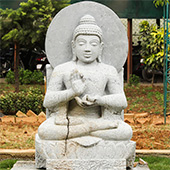The sculpture is an art of making two or three-dimensional representative or abstract forms by using stone, metal, wood, clay and POP (Plaster Of Paris). Whereas the stone sculpture is a three-dimensional object, shaped by the controlled removal of stone. Ajanta and Ellora and shiva temple in Elephanta caves are the best examples of stone carving. The sculptural progress has been marked by the discovery of new materials as well as equipment. Prehistoric art is dominated by cave art. Prehistoric sculptors were using mammoth bones and ivory for carving (ivory encompasses any animal tooth and tusk) as well as the more unpreserved wood. As the tools became stronger during the later Mesolithic and Neolithic periods, Stone Age sculptors start to carve with marble, limestone, porphyry and also granite. The ‘Venus of Berekhat Ram’ and ‘The Venus of Tan-Tan’ are the two earliest known primitive stone effigies. The earliest prehistoric form of carving of animals, birds and also human figures.
The tradition of Indian sculpture extends from the Indus Valley Civilization of 2500 to 1800 BCE, during that time small terra-cotta figurines were produced. The most famous Indus sculpture is the figurative bronze known as ‘The Dancing Girl of Mohenjo-Daro’. The monumental stone sculpture story begins with the Mourya Dynasty, when the sculptors started to carve illustrative scenes from three main religions in India – Hinduism, Jainism and Buddhism (Pillars of Ashoka). The Mauryan emperor Ashoka decided to spread the Buddhist faith through the construction of 85,000 stupas, decorated with Buddhist writings and imagery engraved on rocks and pillars. The ‘Great Stupa at Sanchi’ is the finest example and the ‘Pillars of Ashoka’ are hewn out of sandstone and topped with capitals decorated with carvings of animals, mainly lions.
Stone was the first material used by prehistoric men to create tools. In India, the tradition of stone carving is one of the richest in the world, as is evident from temples in Khajuraho, Konark, Martand in Kashmir, Ellora, Belur and Halebidu, Banavasi, Badhami etc., which have richly carved sculptures and relief work on them. Indian craftsmen use different types of stones like marble, soapstone and sandstone etc. Later 20th and early 21st-century sculpture has assumed a central position in contemporary art and followed the patterns of several postmodern art movements. The architecture of Karnataka can be traced back to the southern Neolithic and early Iron Age. Mysore Kingdom (Wodeyar) rule has also given an architectural master structure in the St.Philomena’s Church at Mysore that was completed in 1956. Whereas in addition to many Dravidian style architectural temples. The historical monuments of Pattadakal and Hampi are listed under the UNESCO World Heritage List of 22 cultural monuments in India. The Kadambas of Banavasi were the ancient royal dynasty of Karnataka from 345 to 525 and made a significant early contribution to the architectural heritage of Karnataka. Kadambas were the originators of the Karnataka architecture.
Karnataka Shilpakala Academy gives an opportunity for sculptors to exhibit their talent through the stone art by supporting the artists and by the end of the camp, the academy honour the sculptors with respect. Academy promotes stone art by choosing artists from various places and also provides a library for sculptors which has a huge collection of books about the sculpture. Recently ‘Karnataka Shilpakala Academy’ organized a Contemporary Stone Sculpture Camp on the premises of KSDL’s Soap factory in Bengaluru from 21st April 2016 to 5th May 2016. The sculpture camp got concluded with a motivating speech by Dr. M H Krishnaiah and Mr. Mahadevappa Shambhulingappa – president, of Karnataka Shilpakala Academy.













